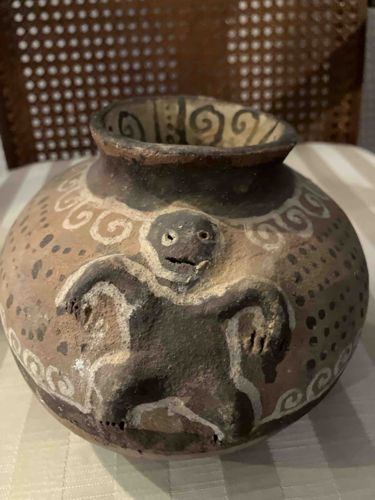
Pre-Columbian Anthropomorphic Effigy Jar
This is a likely Pre-Columbian effigy jar, hand-built from earthenware or terracotta, with a rounded, globular body and a slightly everted, short neck. The primary color of the pottery appears to be a reddish-brown to light brown, suggesting local clay materials. A prominent anthropomorphic figure, possibly depicting a shaman or deity, is molded in high relief on one side of the vessel, rendered in a darker, contrasting brown or black pigment. The figure has distinct facial features, including round eyes and an open, somewhat grimacing mouth, with arms and legs splayed in an active pose. The surface of the jar is extensively decorated. White and dark brown/black pigments are used to create spiral motifs, dots, and curvilinear patterns around the neck, shoulders, and base of the vessel, as well as outlining parts of the effigy figure. These patterns seem to be applied freehand, indicating traditional craftsmanship. The texture of the pottery appears somewhat coarse, characteristic of ancient hand-coiled or molded ceramics. Visible condition issues include significant wear, particularly to the applied pigments, which show fading and some loss. There are also pitting and minor abrasions on the surface, consistent with age, handling, and possible burial. No obvious cracks or repairs are immediately discernible from the image, but the overall patina suggests considerable age. The construction indicates traditional, possibly ancient, methods of pottery making without the use of a potter's wheel. The unique figural representation and decorative elements suggest a cultural significance, possibly related to ritualistic or ceremonial purposes.
AI-Generated Appraisal Disclaimer
Estimated Value
$600-900
Basic Information
Category
Ancient Pottery
Appraised On
December 18, 2025
Estimated Value
$600-900
Item Description
This is a likely Pre-Columbian effigy jar, hand-built from earthenware or terracotta, with a rounded, globular body and a slightly everted, short neck. The primary color of the pottery appears to be a reddish-brown to light brown, suggesting local clay materials. A prominent anthropomorphic figure, possibly depicting a shaman or deity, is molded in high relief on one side of the vessel, rendered in a darker, contrasting brown or black pigment. The figure has distinct facial features, including round eyes and an open, somewhat grimacing mouth, with arms and legs splayed in an active pose. The surface of the jar is extensively decorated. White and dark brown/black pigments are used to create spiral motifs, dots, and curvilinear patterns around the neck, shoulders, and base of the vessel, as well as outlining parts of the effigy figure. These patterns seem to be applied freehand, indicating traditional craftsmanship. The texture of the pottery appears somewhat coarse, characteristic of ancient hand-coiled or molded ceramics. Visible condition issues include significant wear, particularly to the applied pigments, which show fading and some loss. There are also pitting and minor abrasions on the surface, consistent with age, handling, and possible burial. No obvious cracks or repairs are immediately discernible from the image, but the overall patina suggests considerable age. The construction indicates traditional, possibly ancient, methods of pottery making without the use of a potter's wheel. The unique figural representation and decorative elements suggest a cultural significance, possibly related to ritualistic or ceremonial purposes.
Get Your Items Appraised
Instant estimates of your treasures with AI-powered instant appraisals